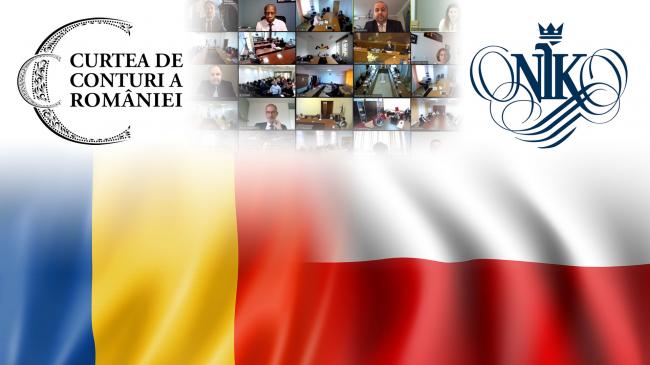The peer review was made in line with the INTOSAI Peer Review Guidelines (GUID 1900, previously ISSAI 5600) and using elements of the SAI PMF[1] methodology. Because of the epidemic, the whole review was carried out on a remote basis. During the review, experts from three involved SAIs analysed regulations, processes and procedures of the Romanian Court of Accounts and held a number of talks during online conferences with employees of the Court of Accounts at different levels, representatives of audited entities, media and non-governmental organisations.
The final product of the peer review is a report including e.g. observations on the way the Romanian SAI operates in areas defined by the peer review and related recommendations. As a rule, this report forms the basis on which the SAI under review prepares an action plan and a strategy aimed at implementing recommendations.
The report was presented on 24 September 2021 by the President of NIK, Vice-President of the Netherlands Court of Audit and representatives of the General Secretariat of INTOSAI – during an online conference attended by all employees of the Romanian SAI (over 1600 persons).
The recommendations focused on four main areas. The first one is related to the need to boost influence of the Romanian SAI on the state functioning and recognisability of that SAI in the society, e.g. by making audit reports more useful and more available, by making sure they are published in a shorter time and ensuring selection of audit subjects which are interesting for citizens. The second area of recommendations is connected with essential changes in the work organisation of Romanian auditors, obligatory monitoring of the way audit recommendations are implemented, elimination of duplicating materials in the audit documentation and promotion of common values inside the organisation. The third group of recommendations deals with the need to improve relations with stakeholders, e.g. by regular meetings with members of Parliament, tightening cooperation with auditees which should be focused on finding solutions to problems identified during audits and using suggestions of citizens when selecting audit subjects. The last group of recommendations is related to audit quality improvement. The auditors’ independence is critical here. Other essential elements include: elimination of burdening and duplicating internal regulations, implementation of the so-called hot review (on-going quality control) and system-based sharing of knowledge and experience inside the organisation.
Participation in peer reviews is consistent with the strategy of NIK’s involvement in international projects. It also facilitates promotion of solutions worked out by NIK in other countries. This is yet another peer review with NIK’s participation. Polish experts undertook similar projects among others for the SAIs of Indonesia, Slovakia, Estonia, Lithuania, Latvia and the European Court of Auditors. Involvement in such initiatives is a confirmation that the international community trusts in the skills and objectivism of the Polish experts. It also helps build the prestige of the Supreme Audit Office of Poland. As a result, NIK is entrusted with significant functions in organisations associating supreme audit institutions (such as EUROSAI and INTOSAI). Besides, NIK is invited to run external audits of international organisations (e.g. the Council of Europe, OECD, CERN) and twinning projects (e.g. for the SAIs of Albania, Kosovo, Azerbaijan, Jordan and Palestine).
[1] Supreme Audit Institutions Performance Measurement Framework – a tool for overall assessment of a SAI’s functioning and compliance with standards, including independence, audit quality and reporting, communication with stakeholders, management and ethics, human resources and trainings, functioning of individual audit types.


